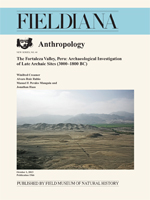Monumental architecture, including stepped pyramids, sunken circular plazas, and upright monoliths (huancas), has been identified at sites throughout the Norte Chico region along the coast of Peru. During 2003 and 2004, test excavations were conducted at six of these sites in the Fortaleza Valley. Excavation included 1 × 2-m test pits and sections cleared along road cuts and looters' pits. Good preservation of plant materials, along with fiber bags, or shicra, used in construction of monumental architecture yielded ample samples for dating. This report describes and illustrates the precise context of the samples and provides the radiocarbon dating results for 80 samples. Project results show that the sites tested were occupied during the Late Archaic Period between 3000 and 1800 BC. The pattern of constructing large mounds paired with sunken circular plazas clearly begins by the third millennium BC, and a U-shaped layout of sites appears to develop during that period, as indicated by the regularity of site plans and monuments at sites such as Caballete and Porvenir.
La arquitectura monumental, incluyendo pirámides escalonadas, plazas circulares hundidas, y monolitos verticales o huancas, han sido identificados en sitios en toda la región Norte Chico en la costa del Perú. Durante 2003 y 2004, las excavaciones de prueba se llevaron a cabo en seis de estos sitios en el Valle de Fortaleza. Las excavaciones incluyeron fosas midiendo 1m x 2 m y secciones despejadas a lo largo de los cortes de carreteras y las fosas de saqueadores. La buena preservación de los materiales vegetales, junto con bolsas hechas de fibra o shicras utilizados en la construcción en la arquitectura monumental dio amplias muestras para poder conseguir la edad por medio de radiocarbono. Este informe describe e ilustra el contexto preciso de las muestras y proporciona los resultados de datación por radiocarbono de 80 muestras. Los resultados del proyecto indican que los sitios analizados fueron ocupadas durante el período Arcaico Tardío entre 3000-1800 antes de Cristo. El patrón de construir grandes montículos emparejado con plazas circulares hundidas comienza claramente durante el tercer milenio antes de Cristo y el plan de construcción en forma de "U" parece desarrollarse durante este periodo, según lo indicado por la regularidad de los planos del sitio y monumentos como Caballete y Porvenir.





